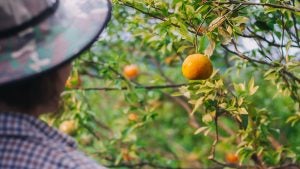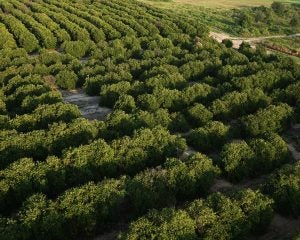We’ve all probably heard the expression or have seen the ads for “Pure Florida quality orange juice.” It’s true that 94 percent of citrus grown in Florida goes to juice!
But I’ve long wondered how the industry is doing, what sort of challenges it faces, and how does it protect waterways and natural resources? To find out, I met with a team of experts to learn the facts:
- Glenn and Mark Beck, Brothers and award winning multi generational citrus growers in central Florida;
- Mike Roberts, Vice President of Griffin Fertilizer;
- David B Royal, Florida Nutrient Stewardship Project Manager with The Nature Conservancy;
- Mary Hartney, President of the Florida Fertilizer and Chemical Association;
- Rob Watson, Sales Representative for Griffin fertilizer
The team put together farm tours and presentations to explain the facts, and they are working hard to share the stories of what they do to protect the environment. Starting with the “4 Rs” for fertilizer application: the
- Right Source — Ensure fertilizer comes from the best source for your crops
- Right Rate — Utilize the right amount based on the soil and crop needs
- Right Time — Use fertilizer when the plant really needs it
- Right Place — Meet the crop’s specific need based on dynamics of your site
Learn more about this extensive program through The American Society of Agronomy in collaboration with the International Fertilizer Association, Fertilizer Canada, The Fertilizer Institute, and The International Plant Nutrition Institute.

Florida growers have a lot of record keeping and regulations to adhere to to protect waterways. It’s best to use the least amount possible at the right time to ensure maximum efficiency, and technology with precision agriculture has also greatly improved their best management practices and reduced fertilizer use. Senate Bill 712, “The Clean Waterways Act,” passed, which works to preserve Florida’s natural resources.
There are many causes of water quality issues in the state but industries working together to improve practices seems promising. Agriculture often times takes the blame for issues, and although they are part of the problem, they’re also a big part of the solution. Public perception is a bit off, mostly due to the fact that many people don’t really understand the industry or are not getting their information from credible sources.
We all eat, but many don’t want to acknowledge the fact that supporting hundreds of millions of people in a state so close to sea level doesn’t come without challenges. Florida has nearly 22 million residents and 125 million tourists each year, and they all flush the toilet, for example. Septic tanks and systems, untreated wastewater, sewage disposal facilities, and storm water runoff play huge roles, but that’s also why industries have regulations to adhere to.
For agriculture, growers must fill out mandatory NARF (or Nutrient Application Record Form) through the Florida Department of Agriculture and Consumer Services, which documents how much phosphorus and nitrogen are used. Agriculture has maximum allowable amounts of fertilizer that can be used per acre, fertilizer companies are audited, and using more than necessary is a waste of time and money and can also have detrimental effects on the crop and is against state regulation. The Florida Department of Environmental Protection (DEP) also has BMAPs in place which stands for Basin Management Action Plan.

Research farms, such as the University of Florida Suwannee Valley Research and Education Center, are also an important way to continue to study ongoing efforts. Probes and sensors ensure nutrients and water are staying within six inches in the soil to maximize their fertilizer efficiency efforts. Irrigation improvements, soil testing, cover crops, Satellite Imagery, plant tissues sampling, No-till and strip-tilling and more show that there are absolutely incredible efforts in place to protect water and natural resources.
With hundreds of millions of residents and tourists in this beautiful state, it’ll never be perfect; we won’t be able to put Humpty Dumpty together again, and it’s said that more than 1,000 people move to the state every day. But at least we can come together and raise awareness on the issues and support the experts that are working on improvements.
Michelle Miller, the Farm Babe, is a farmer, public speaker and writer who has worked for years with row crops, beef cattle, and sheep. She believes education is key in bridging the gap between farmers and consumers.



